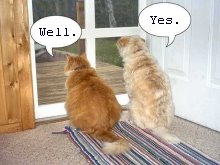Beeswax can wax your moustache or seal your dreadlock, shine your furniture, thread your needle, quiet your squeaky drawer, turn a screwy screw, loosen that rusty nut, get the wax out of your ears or plug your ears, clean your iron, clean your oil spill, polish, add patina, help waterproof. You’ll find beeswax in art and you’ll find beeswax in crafts. You’ll find beeswax in oboe reeds, bagpipes, accordions, and didgeridoos. It lurks in your cosmetics and balms and ointments, in your candy and your crayons. I hear it can soothe a cracked hoof and help you pluck a duck.
In short, there’s very little beeswax can’t do. Well, it can’t make you dinner; it can’t make you thinner. It can’t trim your toenails or answer your emails. It can’t do your math or draw you a bath. It won’t win you the lottery (or even slip you a ten), and it won’t show you where you went wrong or point you in the right direction. (Or will it?) No matter, beeswax can brighten your dark corners, sweeten the air, and shoosh your squeaks.
But what, exactly, is it?
I like The New World Family Encyclopedia description from 1954:
Another use of beeswax is in the apiary industry itself—beekeepers provide their bees with wax foundations on which to build their honeycombs. And then there are beeswax candles, which may be the most widely recognized use of beeswax. Beeswax candles have a brighter flame and burn cleaner and longer than paraffin candles. They also have a subtly sweet scent of honey and flowers and wildness, which they come by naturally. I’ve read that beeswax releases negative ions when burning, thus cleaning the air and brightening one’s mood. A few centuries ago the Roman Catholic Church decided beeswax candles were the only way to go, and churches today still prefer these candles to others.
Beeswax is easily molded and has long been used for making ornaments. Not much affects beeswax—it is considered a stable compound—and beeswax ornaments may well last forever, smelling sweetly all the while. Unless, of course, you store them away in a hot attic—beeswax will melt soon after topping 140 degrees.
I became interested in beeswax while helping a beekeeper friend sell product at an outdoor craft fair this summer. Mostly he sells honey wholesale to stores, but he has two shows he attends each year, one in the summer and one in December. At the shows he sells honey, maple syrup, gift baskets, beeswax candles, beeswax ornaments, and blocks of beeswax. In typical fashion I was there to help, yet when someone asked me what a person might do with a block of beeswax I just shrugged my shoulders and said, “Well …”
My friend the beekeeper jumped in with some beeswax uses (the person still looked a bit confused, which is not a comment on my friend, but rather on a person who is perhaps more used to working with WD-40 and spit and who prefers frozen chicken drumsticks to fresh duck), and a bit later a young woman stopped by the table, buying without a word a few blocks of beeswax.
“What do you do with all that beeswax?” I asked.
Rather than saying “none of your beeswax” she said, “I’m a bookbinder. I hand stitch books. I run the thread through the beeswax first. It’s easier that way.”
I was still trying to process “I’m a bookbinder.” I mean, how many bookbinders does one meet in a day, a week, or a year? I guess it depends on who you’re hanging with. Before I could think of an intelligent question or comment, she was gone. (It was a hot day, if that’s any excuse.)
Now it’s time for the December show and I want to be prepared when someone asks me about beeswax, so I went online to do a little research and came up with some answers. Now when someone asks, “What does one do with beeswax?” I can say, “Got a duck to pluck?” I am reluctant, though, to mention the duck plucking, because although I’ve read about it, I’ve never done it, and I don’t want someone coming back to the show next year with some kind of scar, blaming the beekeeper, calling him a quack, because I said something about ducks and beeswax that turned out to be not quite true. After all, I am trying to help. But beeswax seems to be one of those materials that’s been around for so long and used for so many different things that I feel, well, people should know about it. Especially the candles, which I have used. And I’ll tell you something. They burn more brightly. They last longer. And they smell lightly sweet. Like honey.
If you're in the neighborhood, stop by the Poor Artists Sale in Calumet Saturday, December 6, and look for the table with the beeswax.
Bee
Where the honey flows
Beeswax products are available through our Stuff for Sale page.
In short, there’s very little beeswax can’t do. Well, it can’t make you dinner; it can’t make you thinner. It can’t trim your toenails or answer your emails. It can’t do your math or draw you a bath. It won’t win you the lottery (or even slip you a ten), and it won’t show you where you went wrong or point you in the right direction. (Or will it?) No matter, beeswax can brighten your dark corners, sweeten the air, and shoosh your squeaks.
But what, exactly, is it?
I like The New World Family Encyclopedia description from 1954:
BEESWAX, the fatty substance secreted by bees and used by them in constructing the honeycomb. It is not collected from plants, but is a secretion elaborated within the body of the animal from saccharine matter or honey, and extruded in scales from beneath the rings of the abdomen. …So beeswax is the result of a digestive, or shall we say elaboration process that takes place inside a honey bee. The process turns sugar into wax which the bee then uses to cap off honey-laden honeycomb cells. In order to get at the honey, a beekeeper must first remove the wax, and thus every beekeeper ends up with two products: honey and beeswax. The encyclopedia entry continues: “… It is an article of commerce, useful in modeling, for candles, and diverse other purposes. Before being put on the market, it is purified and bleached or whitened.” But these days I think most people prefer their beeswax to be unbleached, imbued with its natural honey color.
Another use of beeswax is in the apiary industry itself—beekeepers provide their bees with wax foundations on which to build their honeycombs. And then there are beeswax candles, which may be the most widely recognized use of beeswax. Beeswax candles have a brighter flame and burn cleaner and longer than paraffin candles. They also have a subtly sweet scent of honey and flowers and wildness, which they come by naturally. I’ve read that beeswax releases negative ions when burning, thus cleaning the air and brightening one’s mood. A few centuries ago the Roman Catholic Church decided beeswax candles were the only way to go, and churches today still prefer these candles to others.
Beeswax is easily molded and has long been used for making ornaments. Not much affects beeswax—it is considered a stable compound—and beeswax ornaments may well last forever, smelling sweetly all the while. Unless, of course, you store them away in a hot attic—beeswax will melt soon after topping 140 degrees.
I became interested in beeswax while helping a beekeeper friend sell product at an outdoor craft fair this summer. Mostly he sells honey wholesale to stores, but he has two shows he attends each year, one in the summer and one in December. At the shows he sells honey, maple syrup, gift baskets, beeswax candles, beeswax ornaments, and blocks of beeswax. In typical fashion I was there to help, yet when someone asked me what a person might do with a block of beeswax I just shrugged my shoulders and said, “Well …”
My friend the beekeeper jumped in with some beeswax uses (the person still looked a bit confused, which is not a comment on my friend, but rather on a person who is perhaps more used to working with WD-40 and spit and who prefers frozen chicken drumsticks to fresh duck), and a bit later a young woman stopped by the table, buying without a word a few blocks of beeswax.
“What do you do with all that beeswax?” I asked.
Rather than saying “none of your beeswax” she said, “I’m a bookbinder. I hand stitch books. I run the thread through the beeswax first. It’s easier that way.”
I was still trying to process “I’m a bookbinder.” I mean, how many bookbinders does one meet in a day, a week, or a year? I guess it depends on who you’re hanging with. Before I could think of an intelligent question or comment, she was gone. (It was a hot day, if that’s any excuse.)
Now it’s time for the December show and I want to be prepared when someone asks me about beeswax, so I went online to do a little research and came up with some answers. Now when someone asks, “What does one do with beeswax?” I can say, “Got a duck to pluck?” I am reluctant, though, to mention the duck plucking, because although I’ve read about it, I’ve never done it, and I don’t want someone coming back to the show next year with some kind of scar, blaming the beekeeper, calling him a quack, because I said something about ducks and beeswax that turned out to be not quite true. After all, I am trying to help. But beeswax seems to be one of those materials that’s been around for so long and used for so many different things that I feel, well, people should know about it. Especially the candles, which I have used. And I’ll tell you something. They burn more brightly. They last longer. And they smell lightly sweet. Like honey.
If you're in the neighborhood, stop by the Poor Artists Sale in Calumet Saturday, December 6, and look for the table with the beeswax.
Bee
Where the honey flows
Beeswax products are available through our Stuff for Sale page.



